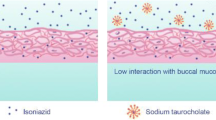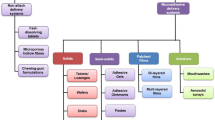Abstract
Purpose. To determine the major routes of buccal transport of acyclovir and to examine the effects of pH and permeation enhancer on drug permeation.
Methods. Permeation of acyclovir across porcine buccal mucosa was studied by using side-by-side flow through diffusion cells at 37°C. The permeability of acyclovir was determined at pH range of 3.3 to 8.8. Permeability of different ionic species was calculated by fitting the permeation data to a mathematical model. Acyclovir was quantified using HPLC.
Results. Higher steady state fluxes were observed at pH 3.3 and 8.8. The partition coefficient (1-octanol/buffer) and the solubility of acyclovir showed the same pH dependent profile as that of drug permeation. In the presence of sodium glycocholate (NaGC) (2−100 mM), the permeability of acyclovir across buccal mucosa was increased 2 to 9 times. This enhancement was independent of pH and reached a plateau above the critical micelle concentration of NaGC. The permeabilities of anionic, cationic, and zwitterionic species were 3.83 × 10−5, 4.33 × 10−5, and 6.24 × 10−6cm/sec, respectively.
Conclusions. The in vitropermeability of acyclovir across porcine buccal mucosa and the octanol-water partitioning of the drug were pH dependent. A model of the paracellular permeation of the anionic, cationic, and zwitterionic forms of acyclovir is consistent with these data. The paracellular route was the primary route of buccal transport of acyclovir, and the enhancement of transbuccal transport of acyclovir by sodium glycocholate (NaGC) appeared to operate via this paracellular route.
Similar content being viewed by others
REFERENCES
R. B. Gandhi and J. R. Robinson. Oral cavity as a site for bioadhesive drug delivery. Adv. Drug Del. Rev. 13:43-74 (1994).
H. Zhang and J. R. Robinson. Routes of drug transport across oral mucosa in M. J. Rathbone (ed.), Oral mucosal drug delivery, Marcel Dekker, Inc., New York, 1996, pp. 51-64.
C. A. Squier and R. M. Hopps. A study of the permeability barrier in epidermis and oral epithelium using horseradish peroxidase as a tracer in vitro. Br. J. Dermat. 95:123-129 (1976).
C. A. Squier and B. K. Hall. The permeability of mammalian non-keratinized oral epithelia to horseraddish peroxidase applied in vivoand in vitro. Arch. Oral Biol. 29:45-50 (1984).
M. C. Alfano, A. J. Chasens, and C. W. Masi. Autoradiographic study of the penetration of radiolabelled dextrans and inulin through non-keratinized oral mucosa in vitro. J. Periodont. Res. 12:368-377 (1977).
M. E. Dowty, K. E. Knuth, B. K. Irons, and J. R. Robinson. Transport of thyrotropin releasing hormone in rabbit buccal mucosa in vitro. Pharm. Res. 9:1113-1122 (1992).
S. Senel, A. J. Hoogstraate, F. Spies, J. C. Verhoef, H. E. Junginger, and H. E. Bodde. Visualization of enhancing effects of bile salts on buccal penetration. Eur. J. Morph. 31:35-41 (1993).
C. A. Lesch, C. A. Squier, A. Cruchley, D. M. Williams, and P. Speight. The permeability of human oral mucosa and skin to water. J. Dent. Res. 68:1345-1349 (1989).
E. Quadros, J. Cassidy, K. Gniecko, and S. LeRoy. Buccal and colonic absorption of CGS 16617, a novel ACE inhibitor. J. Control. Rel. 19:77-86 (1991).
C. A. Squier and B. K. Hall. The permeability of skin and oral mucosa to water and horseradish peroxidase as related to the thickness of the permeability barrier. J. Invest. Dermat. 84:(1985).
A. J. Hoogstraate, C. Cullander, J. F. Nagelkerke, J. Verhoel, H. E. Junginger, and H. E. Bodde. Diffusion rates and transport pathways of FITC-labelled model compounds through buccal epithelium. Proceed. Int. Symp. Control. Rel. Bioact. Mater. 20:234-235 (1993).
A. J. Hoogstraate, S. Senel, C. Cullander, J. Verhoef, H. E. Junginger, and H. E. Bodde. Effects of bile salts on transport rates and routes of FTIC-labelled compounds across porcine buccal epithelium in vitro. J. Control. Rel. 40:211-221 (1996).
A. J. Hoogstraate, H. E. Bodde, C. Cullander, and H. E. Junginger. Diffusion rates and transport pathways of FITC-labelled model compounds through buccal epithelium. Pharm. Res. 9:S-188 (1992).
A. J. Hoogstraate, J. C. Verhoef, B. Tuk, A. Pijpers, L. A. M. G. van Leengoed, J. H. M. Vheijden, H. E. Junjinger, and H. E. Bodde. Buccal delivery of fluorescein isothiocyanate-dextran 4400 and the peptide drug buserelin with glycodeoxycholate as an absorption enhancer in pigs. J. Control. Rel. 4:77-84 (1996).
A. H. Beckett and A. C. Moffat. Correlation of partition coefficients in n-heptane-aqueous systems with buccal absorption data for a series of amines and acids. J. Pharm. Pharmacol. 21:144S-150S (1969).
P. P. H. Le Brun, P. L. A. Fox, M. E. de Vries, and H. E. Bodde. In vitropenetration of some β-adrenoreceptor blocking drugs through porcine buccal mucosa. Int. J. Pharm. 49:141-145 (1989).
K. W. Garren and A. J. Repta. Buccal drug absorption. II. In Vitrodiffusion across the hamster cheek pouch. J. Pharm. Sci. 78:160-164 (1989).
A. H. Beckett and A. C. Moffat. Kinetics of buccal absorption of some carboxylic acids and the correlation of the rate constants and n-heptane:aqueous phase partition coefficients. J. Pharm. Pharmacol. 22:15-19 (1970).
I. A. Siegel, K. T. Izutsu, and E. Watson. Mechanisms of nonelectrolyte penetration across dog and rabbit oral mucosa in vitro. Arch. Oral Biol. 26:357-361 (1981).
A. Martin, P. Bustamante, and A. H. C. Chun. Physical Pharmacy, Lea & Febiger, Malvern, PA. 1993, pp. 362-393.
J. Zhang, J. Streisand, S. Niu, D. Coleman, B. Hague, L. Maland, and T. Stanley. Buccal mucosal absorption of esmolol in an in vivodog model. Pharm. Res. 9:S-177 (1992).
O. Al-Sayed-Omar, A. Johnson, and P. Turner. Influence of pH on the buccal absorption of morphine sulphate and its major metabolite, morphine-3-glucuronide. J. Pharm. Pharmacol. 39:934-935 (1987).
A. H. Beckett and E. J. Triggs. Buccal absorption of basic drugs and its application as an in vivomodel of passive drug transfer through lipid membranes. J. Pharm. Pharmacol. 19:31S-41S (1967).
A. H. Beckett and A. C. Moffat. The influence of substitution in phenyacetic acids on their performance in the buccal absorption test. J. Pharm. Pharmacol. 21:139S-143S (1969).
C. L. Barsuhn, L. S. Olanoff, D. D. Gleason, E. L. Adkins, and N. F. H. Ho. Human buccal absorption of flubriprofen. Clin. Pharmacol. Ther. 44:225-231 (1988).
D. Hicks. The buccal absorption of some β-adrenoceptor blocking drugs. Br. J. Pharmacol. 47:680P-681P (1973).
A. Kristl, A. Mrhar, and F. Kozjek. The ionisation properties of acyclovir and deoxyacyclovir. Int. J. Pharm. 99:79-82 (1993).
A. Tsuji, E. Miyamoto, N. Hashimoto, and T. Yamana. GI absorption of beta-lactam antibiotics II: Deviation from pH-partition hypothesis in penicillin absorption through in situand in vitrolipoidal barriers. J. Pharm. Sci. 67:1705-1711 (1978).
C. A. Squier, P. Cox, and P. W. Wertz. Lipid content and water permeability of skin and oral mucosa. J. Invest. Dermat. 96:123-126 (1991).
Author information
Authors and Affiliations
Rights and permissions
About this article
Cite this article
Shojaei, A.H., Berner, B. & Li, X. Transbuccal Delivery of Acyclovir: I. In Vitro Determination of Routes of Buccal Transport. Pharm Res 15, 1182–1188 (1998). https://doi.org/10.1023/A:1011927521627
Issue Date:
DOI: https://doi.org/10.1023/A:1011927521627




